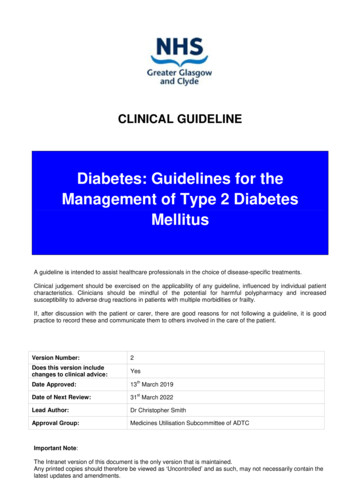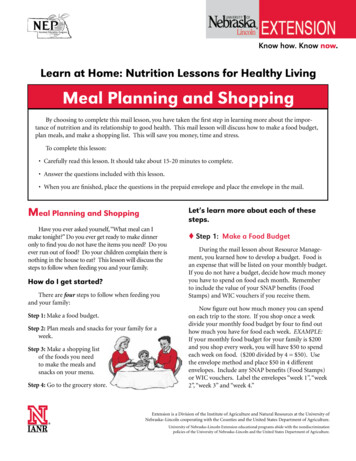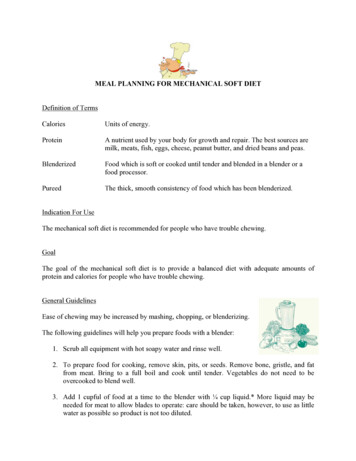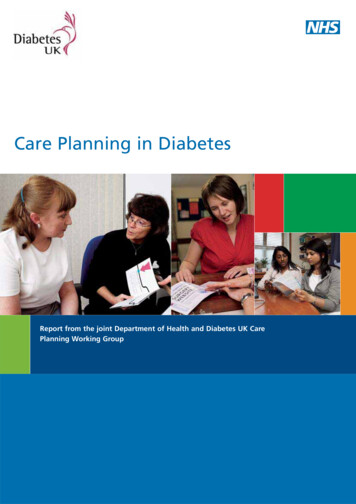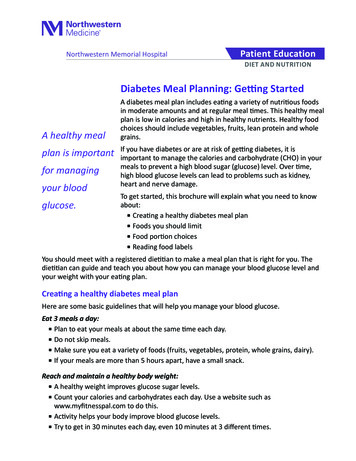
Transcription
Northwestern Memorial HospitalPatient EducationDIET AND NUTRITIONDiabetes Meal Planning: Getting StartedA healthy mealplan is importantfor managingyour bloodglucose.A diabetes meal plan includes eating a variety of nutritious foodsin moderate amounts and at regular meal times. This healthy mealplan is low in calories and high in healthy nutrients. Healthy foodchoices should include vegetables, fruits, lean protein and wholegrains.If you have diabetes or are at risk of getting diabetes, it isimportant to manage the calories and carbohydrate (CHO) in yourmeals to prevent a high blood sugar (glucose) level. Over time,high blood glucose levels can lead to problems such as kidney,heart and nerve damage.To get started, this brochure will explain what you need to knowabout: Creating a healthy diabetes meal plan Foods you should limit Food portion choices Reading food labelsYou should meet with a registered dietitian to make a meal plan that is right for you. Thedietitian can guide and teach you about how you can manage your blood glucose level andyour weight with your eating plan.Creating a healthy diabetes meal planHere are some basic guidelines that will help you manage your blood glucose.Eat 3 meals a day: Plan to eat your meals at about the same time each day. Do not skip meals. Make sure you eat a variety of foods (fruits, vegetables, protein, whole grains, dairy). If your meals are more than 5 hours apart, have a small snack.Reach and maintain a healthy body weight: A healthy weight improves glucose sugar levels. Count your calories and carbohydrates each day. Use a website such aswww.myfitnesspal.com to do this. Activity helps your body improve blood glucose levels. Try to get in 30 minutes each day, even 10 minutes at 3 different times.
Manage your blood sugar: Take medicines as prescribed. Eat 3 meals a day and planned snacks. Count your calories and carbohydrates daily. Do routine blood glucose checks. Exercise. Follow your healthcare provider’s guidelines.Enjoy healthy carbohydratesWhile all foods can affect your blood glucose, carbohydrates (CHOs) may have thebiggest impact. A Consistent Carbohydrate Meal Plan can help manage your bloodglucose. This means that you eat the same amount of CHOs at each meal. Examples ofhealthy CHOs are: Starches (whole grain bread, brown rice, whole grain pasta) Beans (lentils, chickpeas) Starchy vegetables (winter squash, potatoes, corn, peas) Fruit (apples, grapes, oranges) Low-fat dairy products (low-fat milk; light, flavored yogurt)Foods to limitOver time, high blood glucose levels can damage your heart and blood vessels. Somefoods can also increase your risk of heart disease and stroke. Avoid foods that are highcalorie and/or high in unhealthy fats such as: Foods high in saturated fats (high-fat meats, such as beef, hot dogs, deli meats,sausage, bacon) Foods with excess fat from animal products (butter, bacon, mayonnaise, cheese,creamy salad dressings, fried foods) Foods with trans fats (margarine, bakery foods, processed foods) Processed foods and added salt (sodium) in your meals Foods high in sugar:- Flavored yogurt- Ice cream- Juice- Dried fruit- Syrup-packed canned fruit- Fruit spread (jams, jellies)- Bakery goods (cookies, cake, pastry)- Candy- Crackers- Sugar-sweetened cereals2
- Sweetened drinks (soft drinks, sweetened drink mixes, Kool-Aid )- Sweeteners (sugar, honey, molasses, syrup) Before choosing to drink alcohol, discuss it with your healthcare provider.Food portion choicesWatch portion sizes: Even healthy foods will cause high blood glucose if you eat too much. Make sure each of your meals has the same amount of CHOs. Follow the My Plate Planner (www.choosemyplate.gov).Use My Plate PlannerCreate a healthy plate that will help to keep your blood glucose levels in an acceptablerange. Select foods from the Appendix Food Charts, and follow the plate method’s 4 easysteps (see Figure 1):1. Draw a line down the middle of your plate and fill 1/2 of your plate with nonstarchy vegetables.2. Draw another line across the middle of the other 1/2 of your plate and fill 1/4 ofyour plate with a grain or starchy vegetable. Fill the final 1/4 of your plate with alean protein.Figure 1: My Plate Planner 2018 Centers for Disease Control (CDC)3
3. A small piece of fruit or a serving of dairy is optional.4. Finish your meal off with a glass of water or other zero-calorie drink option.Reading food labelsFood labels contain important information to help you manage your meal plan (seeFigure 2).Since carbohydrates have a big impact on your blood glucose, it is important to keeptrack of how many carbohydrates you eat. Carbohydrates are measured in grams (g).Figure 2: Food Nutrition Label1. Find the serving size.2. Find the calories (amount per serving). Counting calories each day will helpyou reach your weight loss goal.3. Find the total carbohydrate per serving. A dietitian can teach you more aboutthe amount of carbohydrate that fitsyour specific needs.4
One serving of carbohydrates is 15 grams. Your care team will talk to you about howmany grams of carbohydrates per day are right for you.A healthy menu example:Breakfast Lunch1/2 cup oatmeal 2 slices whole1 cup berriesgrain bread1 cup skim milk 3 ounces sliced1 Tbsp peanutturkeybutter 1 Tbsp mustard 1 cup carrot sticks 1 small appleDinnerSnack 3 to 4 ounces baked 1/3 cup hummusfish 1 cup cucumbers 2/3 cup brown rice 1 cup cooked broccoli 1 cup salad 1 Tbsp salad dressing 1 cup raspberriesThis menu example shows 3 to 4 servings of carbohydrates at each meal.These are general guidelines. To tailor your meal plan to your specific needs, arrangeto meet with an outpatient registered dietitian by calling the Northwestern Center forLifestyle Medicine at 312.695.2300 or the Center for Integrative Medicine at 312.926.DOCS (3627). They can assist you with making an appointment for a personalizedconsultation.For more information about diabetes, call the American Diabetes Association (ADA) at800.DIABETES (800.342.2383) or visit www.diabetes.org.Northwestern Medicine – Health Information ResourcesFor more information, contact Northwestern Memorial Hospital’s Alberto Culver Health LearningCenter (HLC) at hlc@nm.org, or by calling 312.926.5465. You may also visit the HLC on the 3rd floor,Galter Pavilion at 251 E. Huron St., Chicago, IL. Health information professionals can help you find theinformation you need and provide you with personal support at no charge.For more information about Northwestern Medicine, please visit our website at nm.org.Para asistencia en español, por favor llamar al Departamento de Representantes para Pacientes al 312.926.3112.The entities that come together as Northwestern Medicine are committed to representing the communities we serve, fostering a culture of inclusion, deliveringculturally competent care, providing access to treatment and programs in a nondiscriminatory manner and eliminating healthcare disparities. For questions, pleasecall either Northwestern Memorial Hospital’s Patient Representatives Department at 312.926.3112, TDD/TTY 312.926.6363 or the Northwestern Medical GroupPatient Representatives Department at 312.695.1100, TDD/TTY 312.926.6363.Developed by: NMH Clinical Nutrition, Center for Integrative Medicine with Medicine Nursing March 2019 Northwestern Memorial HealthCare900837 (3/19) Diabetes Meal Planning: Getting Started
Carbohydrates (CHO)Foods that increase your blood glucose:Starch (1 serving 15 g of CHO)Other Starches and Sweets(1 serving 15 g of CHO) 1 slice bread 6-inch tortilla 1/2 English muffin, hamburger bun or hotdog bun 1 small pita 1/4 bagel (1 ounce) 1 waffle or pancake (4-inch round,1/4 inch thick) 3/4 cup unsweetened, dry cereal 1/2 cup sweetened or bran cereal 1/2 cup cooked cereal (oatmeal, grits,kashi, bulgur) 1/3 cup cooked pasta, rice, couscous,quinoa 4 to 6 crackers (2-inch) 3/4 ounces (15 to 20) pretzels, snackchips 3 cups light popcorn 3 Tbsp flour (dry) 1/2 cup casserole or lasagna, macaroniand cheese, pasta with meat sauce 1 cup broth-based soup 1/2 cup cream-based soup or chili 1 Tbsp sugar, syrup, jam, jelly or honey 2 Tbsp light syrup 2-inch square cake or brownie,unfrosted 1 to 2 small cookies 1/2 cup ice cream, gelatin or frozenyogurt 1/4 cup pudding, sherbet or sorbet 1/2 cup sugar-free puddingFruit (1 serving 15 g of CHO)Milk (1 serving 15 g of CHO) 1 small fresh fruit (tennis ball size)1/2 large fruit1/2 cup unsweetened applesauce1/2 cup canned fruit in own juice or water1/2 banana (4-inch length)3/4 cup blueberries or blackberries1 1/4 cup strawberries1/3 cantaloupe or honeydew (1 cup cut)1 wedge watermelon (1 inch thick)17 medium grapes1/2 small papaya1/2 grapefruit (large)2 Tbsp raisins or “craisins”1/4 cup dried fruit pieces3 dried plums, dates or figs1/2 cup unsweetened juice1/3 cup prune, grape or cranberry juice1 cup fat-free, skim or reduced-fat milk1 cup unsweetened soy milk1 cup buttermilk1 cup Lactaid milk1 cup kefir6 ounces flavored plain yogurtAll food products are not created equal. Be sure to read the food labels of the foods youchoose to get the correct serving size and nutritional information for that product.
Other Food GroupsFoods that have little effect on blood glucose:Non-starchy VegetablesProteins(1 serving 15 g of CHO) 1/2 cup cooked vegetables 1 ounce lean meat, 1 cup raw vegetablesfish, poultry or shellfish 1/2 cup tomato or 1/4 cup low-fat cottagevegetable juicecheese 1 ounce low-fat cheeseAny vegetables except corn, 1 egg or 1/4 cup eggpeas, potatoessubstitute 1/4 cup nutsNon-starchy vegetables 1 Tbsp peanut butterinclude onions, asparagus, 1/2 cup tofugreen beans, broccoli,tomatoes, peppers, jicama,kale, carrots, cucumber,lettuce, spinach, cabbage,cauliflower, eggplant, celeryFats(1 serving 15 g of CHO) 1 tsp margarine, butter oroil 1 Tbsp reduced-fatmargarine, butter, mayo orcream cheese 2 Tbsp reduced-fat sourcream, salad dressing, orhalf and half 1/4 cup avocado 1 Tbsp nuts (6 to 7 nuts) 10 olives 1 Tbsp sesame orsunflower seedsAll food products are not created equal. Be sure to read the food labels of the foods youchoose to get the correct serving size and nutritional information for that product.
A diabetes meal plan includes eating a variety of nutritious foods in moderate amounts and at regular meal times. This healthy meal plan is low in calories and high in healthy nutrients. Healthy food choices should include vegetables, fruits, lean protein and whole grains. If yo

